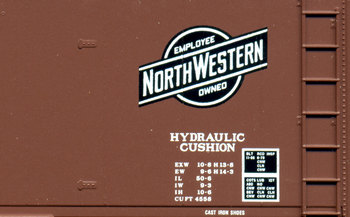Speed Lettering 13 – train speed and the logotype [Column_Letters & Figures]
 : MTL32230 represents C&NW logotype
: MTL32230 represents C&NW logotypeAs I mentioned before, Italic fonts didn’t have the meaning or intention of speed at their origin; it is said that the original purpose of creating the italic font was to save space/expensive paper in 15c.
Also mentioned before is that I think the meaning of speed of the italic fonts was generated when railroads began adopting them to their logotypes.
As far as I know, the first class 1 railroad who introduced speed lettering herald is Chicago and North Western (and subsidy Chicago, St. Paul, Minneapolis, and Omaha) in 1891. Following is Great Northern in 1895, Duluth, South Shore and Atlantic in 1905.
Here is my question this time; why C&NW and the followers introduced italic fonts for their logotypes?
First, I came to the thought that these pioneers were speed conscious. So I compared the speed of trains using the Sep. 1966 Official Guide of the Railways. I should use Official Guide printed in the 1890s but I don't have any.
I calculated the tabular speeds of famed named trains run by class 1 railroads.
For example, NYC’s train No. 25, the Twenties Century Limited departs New York on 18:00. Running entire 960.7miles, the train arrives Chicago on 10:00 the next day. Therefore the train’s tabular speed is 960.7 miles / 16 hours = 60.04 miles/hour.
Average tabular speed of all the class 1 railroads' named passenger trains (43 trains) is 49.69 miles/h.
Average tabular speed of passenger trains run by class 1 railroads who uses regular font for the logotype (35 trains) is 50.13 miles/h.
Average tabular speed of passenger trains run by class 1 railroads who use italic font for the logotype (8 trains) is 47.76 miles/h.
Contrary to the expectation, the average tabular speed of the trains run by railroads who use italic font for the logotype is slower than those by railroads using the regular font.
Thus, I may say that the railroads using italic font for their logotypes run slower trains than those who use regular font for the logotypes. Therefore, it is difficult to say that speed conscious railroads introduced italic font to their logotypes: we cannot find the relation between speed and italic font when railroads began using italic font for their logotypes.
fore mentioned page concerning speed lettering;
http://riogrande.blog.so-net.ne.jp/2011-08-19
以前にも記したように、斜体に、当初から「スピード」あるいは「躍動」といった意味あるいは意図が備わっていた訳ではない。筆者は、鉄道会社がロゴに斜体を用いることによって、鉄道会社自身を含む社会は斜体にあらかじめ備わっていた性能を事後的に見いだした、という仮説を提起した。
筆者がクラス1に分類される鉄道を調べた限りでは、Chicago and North Western(と傍系の Chicago, St. Paul, Minneapolis and Omaha)が、1891年に最初に斜体を使用するロゴタイプを導入している。続いて、Great Northernが1895年、Duluth, South Shore and Atlanticが1905年に斜体を使用するロゴタイプを導入している。
導入時に、斜体にスピード感というイメージが備わっていなかったなら、なぜC&NWはロゴタイプに斜体を用いようと考えたのか。その理由について考察してみたい。
まず、先に挙げた、斜体を用いるロゴタイプを最初に導入した先駆者たちと速度との関係について、時刻表(The Official Guide)のデータを用いて検討してみた。斜体を用いるロゴタイプを導入する鉄道の列車の方が、正体(普通の文字)を用いるロゴタイプを導入する鉄道の列車より早そうに思えたからである。
時刻表を使って、クラス1の鉄道が走らせていた特急列車43本の表定速度を算出してみた。すると全列車の平均表定速度は時速49.69マイルであった。正体を用いるロゴタイプを導入する鉄道のみ(35本)では時速50.13マイル、斜体を用いるロゴタイプを導入する鉄道のみ(8本)では時速47.76マイルであった。
結果的に、予想に反して、斜体を用いるロゴタイプを導入する鉄道の列車の方が、正体を用いるロゴタイプを導入する鉄道の列車より遅いといえることが分かった。したがって、表定速度の早い鉄道が、斜体を用いるロゴタイプを導入したとはいえない。すなわち、ロゴタイプに斜体を用い始めた際、速度やスピード感と斜体には関係性がなかったといえる。
2012-06-15 13:49
コメント(0)




コメント 0